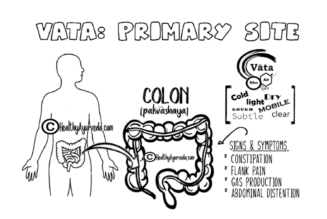THE BASICS FOR MANAGING VATA TYPES:
The management of vata types can be explained in just one word, “relax”. Vata individuals are made primarily of the air element and therefore, just like the wind, are always moving. Due to the ‘air’ element, vata types often experience cold, dry, light, and mobile qualities. Therefore, from a simple perspective, management for vata types is centered around principles of:
– Warming
– Moistening and
– Weight promoting
Ayurveda describes an interesting relationship of taste and its influence upon the body. According to this philosophy, vata types often are most balanced by sweet, sour and salty tastes. Interestingly, these tastes [sweet, sour and salty] are considered to be moistening and nutritive in action; the very management goals for vata types.
VATA IN A NUTSHELL:
dryness, pain, irregularity, nervous imbalance, weight loss, cold and lightness
VATA WARNING BELLS:
- Irregular Digestion
- Increased Anxiety and Worry
- Insomnia
KEEPING IT SIMPLE:
Several considerations for helping to balance vata types:
– eat more warm, brothy and easily digestible foods
- eat at regular times to help promote balance in life
- avoid stimulating foods [i.e. coffee, tea, tabaco and spicy foods]
- avoid foods which are dry, cold, and light
- consider eating more ‘healthy oils’ [ghee, flax, hemp, sesame]
VATA QUALITIES AND THIER MANIFESTATIONS:
– Dry
- Light
- Cold
- Rough
- Mobile
DRY:
Due to the dry quality, vata types are often vulnerable to dry skin, dehydration and even that annoying cracking and popping of the joints.
LIGHT:
The light quality, if increased, can make vata types feel ungrounded, light-headed and even lead to insomnia if this quality persists.
COLD:
If you ever shake the hands of a vata type, you will take notice of cold hands. Vata types are most sensitive to cold weather and will often experience pain and stiffness in muscles and joints, specifically in cold weather.
ROUGH:
Vata types are vulnerable to developing dry, rough, and scaly skin. Likewise, the inner lining of the body [i.e. mucosal lining] can also become dry and rough and according to this principles is the underlying cause of fissures along the mucosal lining.
MOBILE:
As mentioned above, the air element of vata types is always moving, resembling the wind. If this mobile quality is increased, this can lead to abnormal movements of the body such as tics, spasms, tremors and even agitation within the mind giving rise to uncertainty and anxiety.



